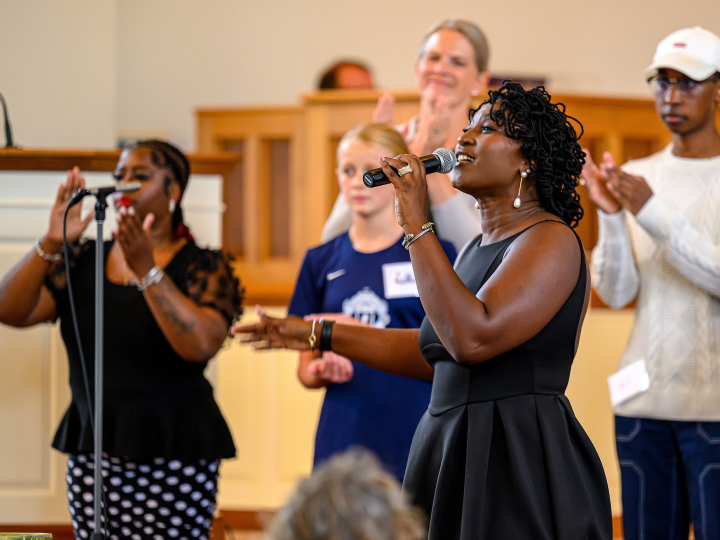Bucknell Answers: Auditory Imagery
February 10, 2016
Research by Bucknell University Professor Andrea Halpern, psychology, proves you don't have to be a musician to imagine music.
Question: What do you mean when you say, "auditory imagery"? How does the imagination interact with the senses?
Answer: A lot of people know immediately what visual imagery is. If I ask you to imagine an elephant, it's pretty easy to do. You're aware that your mind is constructing an elephant, but you're also aware there's no actual elephant, either in the room or in your head. That's a kind of perceptual memory. You have to remember what an elephant is, then retrieve it and have it in your consciousness.
We can do that for other kinds of information from the different senses. For instance, there's motor imagery. You can imagine the feel of playing a sport or the piano, or the feel of sandpaper.
For auditory imagery, you can imagine the voice of a familiar person or a movie actor. You can imagine environmental sounds, like the sound of waves crashing against the shore. I study auditory imagery, particularly, but not exclusively, for music. You can imagine your favorite Christmas carol, for example.
Q: What drew you to study auditory imagery?
A: I'm interested in memory and auditory imagery is an interesting kind of memory experience. It's very salient to people. It also — for the most part, but not all the time — can be under conscious control. It's a kind of memory that people can make use of in the sense that they can be creative with it or use it for music rehearsal.
Q: Is this how deaf musicians are able to compose long after they lose their hearing?
A: Yes. Some individuals who have lost their hearing — not even composers, just deaf individuals — can imagine sounds long after their actual hearing has gone. But ordinary people can, if you will, compose in their heads. Imagine the carol "Silent Night." Now re‑imagine it so that the second note of the tune goes down instead of up. You're not Beethoven, but you just recomposed the song in your head.
Q: How does the brain process sounds that are imagined rather than heard?
A: My colleagues and I have used the methods of cognitive neuroscience to look at the brain while subjects do auditory imagery tasks. On one hand, there's some overlap in the neural areas between auditory imagery and actually hearing tunes.
However, so far as we can tell, the part of the brain that first gets sound — what we call the primary auditory cortex — does not participate in auditory imaging.
An area of the auditory part of the brain is active when you're only imagining tunes. This is what we call the secondary auditory cortex. But there are also parts of the brain that are active when you are imagining that aren't active when you're hearing.
In some cases, when you're manipulating sound in your head, there is strong activation of the part of the brain called the parietal lobe, which is involved in attention. That suggests that these executive functions are coming into play on top of the perceptual part, which describes auditory imagery pretty well: It is a perceptual and memory experience.
Q: Can a person's ability to imagine sounds predict other behaviors?
A: People differ in their ability to imagine sounds and in their reporting of how vividly they imagine them. That predicts some other things that people do.
For instance, people who report that they can imagine sounds in their head more vividly tend to sing better. They pitch-match better. They also have more activation of a link between that auditory area and those executive areas of the brain. We can see that in a brain-by-brain analysis.
Q: Is your research based on self-reporting?
A: I do use a questionnaire with a self-report scale, but I give objective tests as well. For instance, I can ask you to imagine the song "Twinkle, Twinkle, Little Star." Then I ask if the second and third notes are the same or different pitches. Then I can ask things like, "Are the second and fourth note the same?" We make the questions harder and harder, then look at people's performance.
The most dastardly one I've ever done is play a familiar melody backward. I usually tell the subject what the song is, but then stick a fake note in. They have to reverse the reversal and tell me if there's a fake note. When I gave that test to a series of musicians, they got roughly 80 to 90 percent correct. I also put them in the scanner and watched their brains as they did that task.
Q: So would, say, Adele ace the questionnaire?
A: Interestingly enough, the correlation between reported vividness of imagery and years of musical training is only about 0.3 on a scale that goes from 0 to 1. It's a modest correlation.
Q: Have any of your findings surprised you?
A: One thing that doesn't surprise me, but is gratifying to know, is that no one tells me I'm crazy when I ask them to imagine things in their head. Very few people, when I survey them, say, "I don't know what you're talking about" — even those who claim they're not musical. On the questionnaire about how vivid a person's imagery is, occasionally, people put a 1 or 2 on a 7-point scale. It's rare, but almost everyone puts a 3 and above as far as vividness. It's kind of universal.

